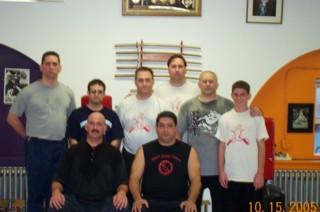Welcome to Fut Sao Wing Chun - Delaware Branch
 Sifu Bruce Nepon (seated left) with his Sifu, Master James Cama (seated right), with students at a recent seminar
Sifu Bruce Nepon (seated left) with his Sifu, Master James Cama (seated right), with students at a recent seminar
What is Buddha Hand Wing Chun?
This Southern Chinese martial art was brought to the United States by Grandmaster Henry Leung. To honor his late teacher, Shaolin Abbot Hsu Yun (also known as "Gao Ghi Fut Sao"), Grandmaster Leung incorporated his Sifu's name into the name of the art. It has the aggressive, springy power for which all Wing Chun is known, but has retained the soft, internal components usually associated with martial arts such as Tai Chi Chuan, Hsing I and Ba Gua.
Don't be confused by terms such as "Traditional" and "Modified" when inquiring about Wing Chun. These are terms that were originally used by members of one Wing Chun lineage to distinguish themselves from other members of the same lineage. Also, don't be misled by martial artists who suddenly add Wing Chun to their curriculum. Sifu Bruce Nepon has been practicing Buddha Hand (Fut Sao), an authentic Cantonese lineage of Wing Chun, since 1983.
Why should you learn Buddha Hand Wing Chun?
Buddha Hand Wing Chun is a very effective fighting art that includes:
- Empty-hand and weapon fighting forms
- Fighting drills for striking, grappling and point attacks
- Techniques for short, medium and long range fighting
- Science that allows a smaller fighter to overcome a larger, stronger opponent
Buddha Hand Wing Chun also offers so much more than just fighting skills:
- Internal energy (chi) circulating exercises
- Correct breathing, posture and relaxation techniques
- Meditation
- Greater strength and flexibility
- Increased confidence and improved concentration